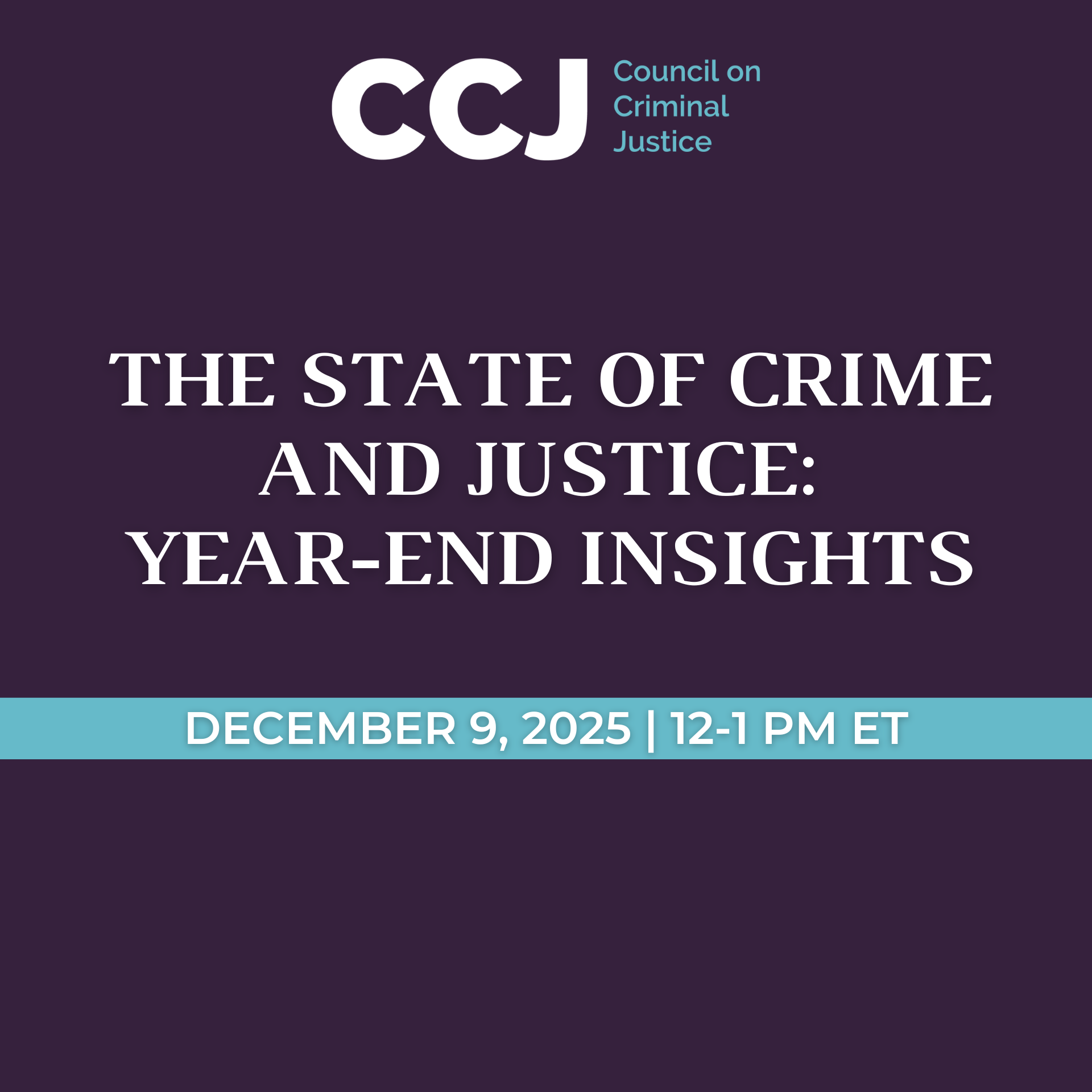On January 22, the leaders of the Council on Criminal Justice Centering Justice initiative – Khalil Cumberbatch and Marc Levin – led a conversation with Bureau of Prisons Director Colette Peters to discuss the First Step Act. The conversation covered lessons the BOP has learned in implementing the multi-faceted legislation and how the agency is tackling risk assessment, programming, staffing, and other challenges.
Following the discussion, CCJ Policy Director Stephanie Kennedy presented an overview of the Council’s original analyses examining the act’s estimated impact on recidivism and on the amount of time served by people released under the law.
This discussion was the second Centering Justice event focused on the First Step Act. In December, CCJ members Louis L. Reed and Ja’Ron Smith reflected on the role bipartisan cooperation played in the passage of the act. You can read the highlights and listen to that discussion here.
Key Challenges Faced by the BOP
- “We need to pay our corrections professionals more. Right now, we are not able to keep up with other law enforcement agencies. We’re not able to keep up with the private sector, [which is] offering work-from-home opportunities and higher salaries.”
- “Recruitment and retention is one of our biggest barriers, but also program space … When we built these prisons in the late 1800s or inherited former mental health hospitals or military bases, those structures weren’t built with programming and treatment in mind.”
- “The First Step Act passed just before the pandemic broke, where we had to social distance, so putting people in classrooms wasn’t the best thing at that moment in time … Now we’re able to free that space up … [We’re] also looking at areas that could be utilized for more program space and using FSA dollars to revitalize those areas and make them program-ready.”
The Renewal of Pell Grants for Incarcerated Students
- “We are thrilled that Congress has expanded Pell Grants … I always say I don’t think there’s one magic pill for success, but if you look at the research and the data around education, it is up there. The dramatic reduction in recidivism for someone who earns a GED, or a four-year degree, or a master’s degree, you drop to almost 0%, as it relates to recidivism. We are thrilled to be able to expand it here at the federal Bureau of Prisons. Each one of our 122 institutions has reached out to at least one community college or university to begin that process. In the way that Pell Grants are set up, we are reliant on those colleges and universities to pave the way for our institutions. We currently have applications out there, and if they are accepted, we’ll double the number of institutions that are able to provide this work.”
- “The National Institute of Corrections just hosted an education summit at the American Correctional Association conference a couple of weeks ago where the Secretary of Education spoke about the importance of education inside and how it mattered not just for those that work and live in prison, but … every citizen in the United States, who should understand how important education in prison is because it impacts us all as it relates to our communities.”
- “We’re thrilled to be leading the way as it relates to GED expansion. We’ll be tracking the expansion of it and our success rates, but already we are seeing more GED graduations now than ever before.”
How the BOP Is Addressing the Needs of Incarcerated Women
- “What the research suggests as well is that many of the people who are incarcerated in the United States, especially the women in our care and custody, can be better served at home. And so, those earned time credits with the First Step Act are allowing those individuals to make their way.”
- “What we’ve learned both in the United States and in other countries is that our correction system needs to be more gender-responsive and more trauma-informed. And so, we have in the last year conducted cultural assessments at all of our female institutions. We have implemented trauma-informed training and gender-responsive training and programs for our women to ensure that they’re receiving the benefits of our programming to the degree that they can. And of course, the First Step Act highlighted things like not restraining individuals who are pregnant or postpartum, which the federal Bureau of Prisons was already compliant with.”
- “[We’re striving to create] an environment where everybody in our custody, but specifically our women, feel comfortable coming forward following any concerns that they might have inside their institutions.”
Residential Reentry Centers
- “We’re always working to expand the number of residential reentry centers. As a former state director who didn’t have access to those step-down halfway houses consistently across all 36 counties in Oregon, I truly believe that those residential re-entry centers are part of the golden ticket and the golden nugget at the federal Bureau of Prisons … [They] provide that safe step down and that closer connectivity to family and employment and all those things that we know make good neighbors.”
- “Funding is always the issue, and so the advancement of programs like in Hawaii is a great example. We have not been able to get a contract with anyone on the island for years now. And … Vermont is struggling without an RRC … So not only do we have geographical pockets that don’t have that residential reentry center, but the advancement of those is really important. How much of a shortage do we have? You know, I don’t have that number today, but I do know that every time we meet with members on the Hill and residential reentry centers come up, we do talk about funding and being able to expand those based on what Congress budgets us in that category.”
Risk and Needs Assessment
- “When I walk the institutions and talk to the adults in custody, they want to know why they’re doing everything they need to do as it relates to being in programs and advancing themselves, but their crime … or their risk level doesn’t allow them to receive those earned time credits. And it is disheartening for them. It’s something that comes up again and again as I walk the halls of our institutions and it’s confusing to them. And so I spend a lot of time talking to them about, yes, unfortunately, the law doesn’t allow you or your risk pattern doesn’t allow you to receive it, but it is advancing your efforts around self-improvement and getting back into the community safely. So, as you know, we worked with the National Institute of Justice to develop the Pattern Risk Tool. It was finalized in January 2020, and we’ve worked to revise it. There were concerns, of course, as there are concerns with all standardized tests and assessments, about any biases. And so the National Institute of Justice worked with the contractors that created it to help eliminate some of those concerns.”
- “We rolled out PATTERN 1.3 in March of last year, which helped address some of those issues. There have been obstacles as we work to revalidate this every year, but we continue to support the work of NIJ and implement the tool to ensure that we’re developing case plans that are based on the individual that’s sitting in front of us, risk, and needs.”
Should People with Criminal Records Be Permitted to Serve as BOP Volunteers?
- “Over the last year, we’ve engaged in multiple listening sessions with advocates, formerly incarcerated individuals, justice-involved individuals, their loved ones, and their family members. And often that’s what we hear, just a passion about wanting to get back inside and help. In the one picture that I showed you where the women were in their purple graduation gowns, the keynote speaker that day was Alice Johnson … It was her first return to Aliceville after being incarcerated there, and she gave just an empowering, inspiring commencement speech to those graduates. And so, we see it firsthand. The warden has the ability to waive people’s backgrounds and involvement in the criminal justice system and allow them to get back inside and volunteer … [And] our strategic plan really was driven a lot by those listening sessions and the feedback that we received from people.”
What's Next for the BOP?
- “In this last 18 months that I’ve been in this role, we’ve worked really hard to work through a lot of hot issues that you all read about in the paper – employee misconduct, accountability, all those sorts of things – creating an environment where both those in our custody and our employees feel comfortable coming forward. We have a great partnership with the Inspector General’s office. In order to make that happen, we’ve doubled down on resources. Our Office of Internal Affairs went from having just over 20 employees to well over 100 to shore up that gap. We engaged in strategic planning, really trying to figure out where we want the bureau to go. We looked at our mission, our vision, and our core values, and we changed them. We’re now using words like normalcy, humanity, and compassion, words that aren’t common in U.S. corrections. We’re trying to implement those in a very meaningful way in a handful of buckets that will be of importance to all of you. Employee wellness includes recruitment and retention, right? If I’m continuing to engage in overtime and augmentation, my people are not feeling well, so we need to solve that problem. Continuing the principles of normalcy and humanity. How do we take these old structures and make them look more humane on the inside through murals and changing furniture and changing layouts, those sorts of things.”
- “We have a lot of work to do with restrictive housing and we have quite a few initiatives to reduce the amount that we are utilizing restrictive housing, ensuring that it’s being utilized for the right reasons. We have a short-term and long-term plan there. The short-term is implementing recommendations that we have inside the bureau right now. Long-term, the National Institute of Justice engaged in a historic ask with us. We have just awarded, through NIJ, a contractor to come in and study our use of restrictive housing across this country and give us some, we hope, bold recommendations moving forward. In this next year, we will be implementing our strategic plan and our strategic vision. We’re saying 2024 is the year of action at the federal Bureau of Prisons. So, we look forward to sharing with you all those changes as we roll them out.”
About the Centering Justice Initiative
- The Centering Justice initiative is a collaborative project engaging a diverse range of the nation’s top thinkers and doers in an ongoing, ideologically vibrant conversation about criminal justice policy.
Additional Resources
- To join the Centering Justice email list, please click here.



